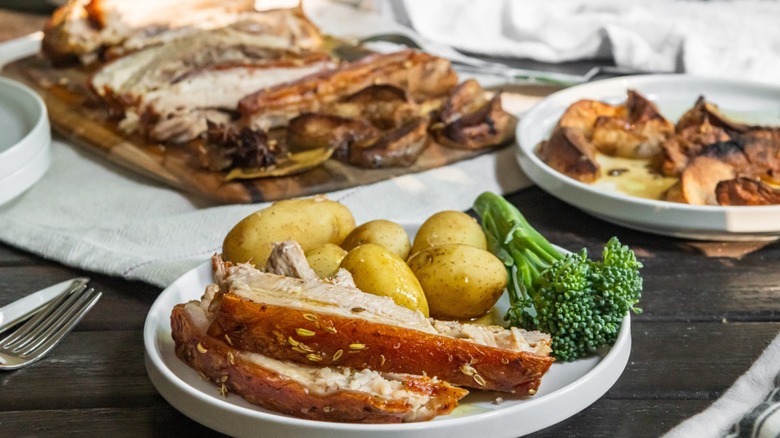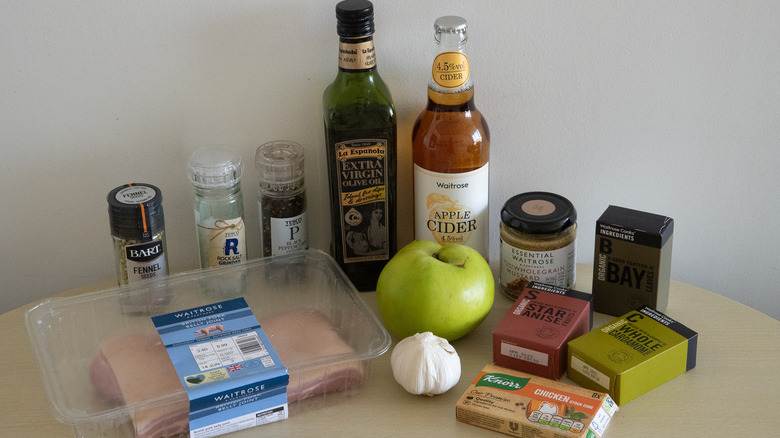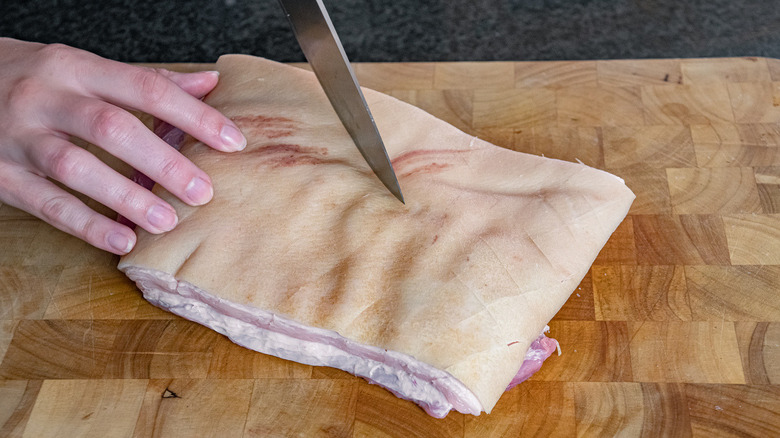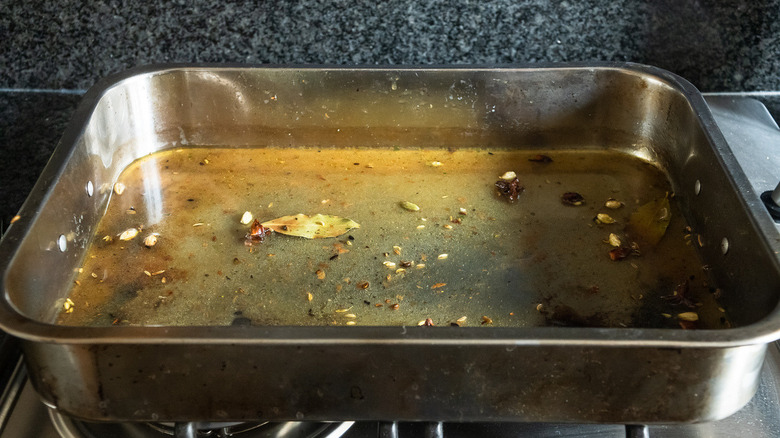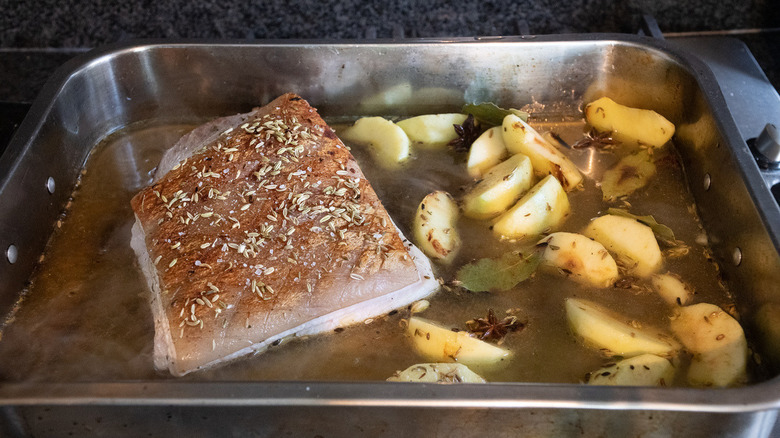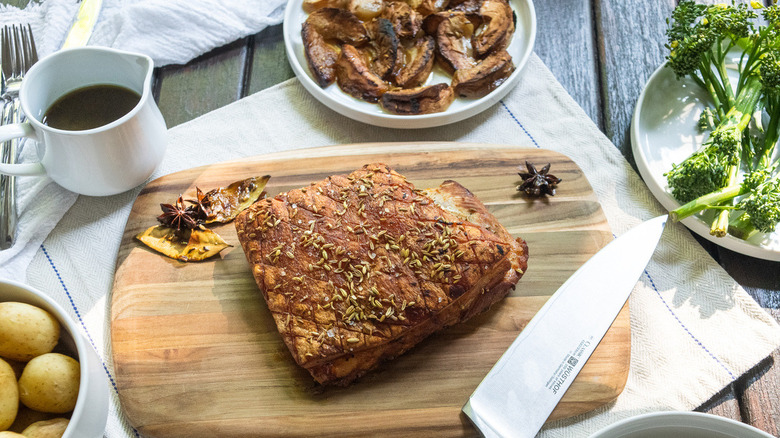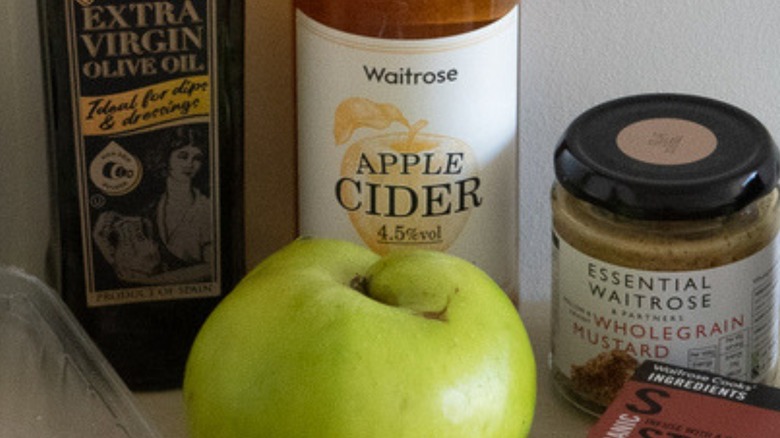Gordon Ramsay's Pork Belly Recipe
Not too long ago, if you told someone you were going to be cooking pork belly for dinner, they might greet that announcement with a look of horror and ask why on earth you'd want to eat a pig's stomach. While we now know that these two pig parts are entirely different entities, not everyone was so pork-savvy back in the day. So what happened? Well, in a word, hipsters. Say what you will about their skinny jeans and their over-use of irony, hipsters may have been the first counterculture in recent memory to turn their focus to food. What's more, apart from a few missteps such as trying to convince people that Brussels sprouts aren't gross, hipster cuisine tended to be so good that even non-millennials were jumping on board with some of the new food fads.
Case in point: Gen-Xer Gordon Ramsay, who was quick to embrace that new hipster favorite, pork belly. Ramsay's pork belly recipe calls for slow roasting this deliciously fatty meat to rich, tender perfection, but even perfection can be improved upon. Recipe developer Jennine Bryant tells us she chose Ramsay's recipe to play with because "pork belly is my husband's absolute favorite meat, so we cook it quite regularly and are always up for new pork belly recipes to try!" She made a few little tweaks (to be disclosed below), and while we'd hate to arouse the infamous Wrath of Ramsay, we daresay Bryant's pork belly is even better than his celebrated version.
Ingredients for this pork belly recipe
To make this pork belly recipe, you'll need a piece about two pounds in size. If you're wondering just where one acquires pork belly if you've never seen it at your local grocery, it is, of course, the sort of thing that specialty butcher shops are likely to carry. If you don't want to pay their prices, though, both Asian and Hispanic groceries tend to be a good bet.
You will also need one or two of what Bryant, who is British, refers to as "cooking apples." If you're making this in the U.S., you'll probably want to use Granny Smiths. You'll also need some seasonings: bay leaves (fresh if you can find them — dry will do if you can't), garlic, cardamom pods, star anise, and fennel seed. For cooking, you'll be using olive oil, apple cider, and chicken stock, and you'll then be finishing things off with some whole grain mustard.
Prepare the pork belly for cooking
First things first: preheat the oven to 350 degrees. While that's heating, you can get the pork belly ready for its starring role in today's recipe by scoring the skin on the diagonal at half-inch intervals, then going back to form a set of diagonals in the opposite direction to make a diamond pattern. Sprinkle the pork belt with salt and pepper, then rub both seasonings into the skin. The scoring should help the seasonings stick if you get them down into the cracks.
Choose the right pan
For the next steps, both Ramsay and Bryant call for some type of roasting pan that will more or less fit on top of one or more stove burners. A Dutch oven would also work, as it can go from stovetop to oven. If you prefer, you can always use a stockpot or large saucepan for the part of the recipe that involves the stove, then transfer the ingredients to a roasting pan for the oven portion.
Start the pork belly on the stove top before roasting
Drizzle some oil into whatever pan you'll be using for the stovetop, then add the sliced apples, bay leaves, garlic, cardamom, star anise, and half of the fennel seeds. Heat them on medium for two minutes until they become aromatic. Now scoot all those ingredients over to the side to make room for the pork belly and place it in the pan, skin-side down. Cook the pork for at least five minutes until it turns golden brown. Turn the pork over, season the skin again with salt, and sprinkle the meat with the remaining fennel seeds. Add the cider to the pan, being careful not to wet the pork skin, and use it to de-glaze the pan by scraping up all the browned bits from the bottom.
Bring the cider to a boil, then add just enough stock to bring the liquid up to the layer of fat that lies just below the pork belly skin (which is now facing up). Let the liquid return to a boil, then turn the stove off and transfer the pan to the now-heated oven. Let it roast for two and a half hours.
Serve the pork belly with a pan sauce
Once the pork belly is done roasting, transfer it to a warm plate and set it aside somewhere to rest. Spoon the fat off the top of the liquid in the pan, or else take a tip from Ramsay and use a piece of bread to sop it up — just the fat, not the other pan juices, since you'll be using those now. Transfer the pan back to the stovetop (or the juices to a pan that can be used on the stovetop) and heat up those juices, whisking in the mustard. Taste the sauce and add any additional seasonings you think it might need.
Remove the star anise and the cardamom pods from the sauce, then pour it into a bowl or, if you have one, here's your big chance to finally use that gravy boat! Serve this sauce alongside the well-rested pork. As Bryant tells us, "Pork belly is a rich meat, so it is quite heavy," and says "We normally serve it with lots of veggies, such as broccoli, carrots, and cabbage." A nice starchy potato side dish might help soak up some of the sauce as well, but you might also want to serve a green salad with an extra-vinegary dressing to offset the richness of the pork belly.
What we changed from Gordon Ramsay's version
So how is our recipe different from Ramsay's? Bryant tells us this version actually has "two twists." She kind of went with a "fall flavors" theme here, as she swapped out Ramsay's white wine for cider instead. By cider, we don't mean the sweet stuff you buy at a farm stand at pumpkin-picking time. Bryant describes the cider she used as "alcoholic and sparkling, with a similar alcohol level to beer or ale." In the U.K., hard ciders are nearly as popular as beer, but here in the U.S., hard cider still lags way behind that other "malternative," hard seltzer. If you'd like to make your pork belly with hard cider, Angry Orchard is one popular brand that's pretty easy to find. If you prefer, though, you could also make this recipe using the non-alcoholic kind of cider, as well.
Okay, so that's one twist. What was the other one? Still in keeping with the cider switch, Bryant also replaced the fennel that Ramsay's recipe calls for with sliced apples. The tartness of the cooking apples plays off nicely against the pork, and we feel it makes for an even better pork belly pairing than does the slightly licorice-y tasting fennel. As Bryant explains, "The apples help to cut through the richness with sweetness and acidity."
Gordon Ramsay's pork belly recipe with a twist
While we'd hate to arouse the infamous Wrath of Ramsay, we daresay Bryant's pork belly is even better than his celebrated version.
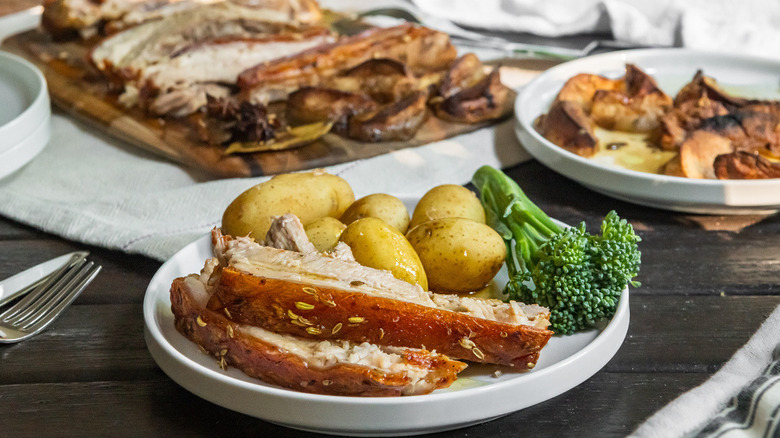
Ingredients
- 2 pounds pork belly
- Sea salt
- Black pepper
- 1 large or 2 small cooking apples, peeled and roughly sliced
- 4 bay leaves
- 3 garlic cloves, peeled and crushed
- 1 teaspoon cardamom pods, crushed
- 4 star anise
- 1 tablespoon fennel seeds
- Olive oil
- 1 1/3 cups apple cider
- 2 to 3 cups chicken stock (depending on pan size)
- 1 tablespoon whole grain mustard
Directions
- Preheat the oven to 350 degrees.
- Score the pork belly skin diagonally in a diamond pattern in half-inch intervals. Season generously with salt and pepper, rubbing it well into the skin.
- Put the apple, bay leaves, garlic, cardamom, star anise, and half of the fennel seeds into a roasting pan with a drizzle of oil. Heat on the stovetop for about 2 minutes until aromatic.
- Push the apple and seasonings to the side of the pan, then add the pork, skin-side down, and cook for at least 5 minutes until it turns golden brown.
- Turn the pork over, season the skin again with salt, and sprinkle with the remaining fennel seeds.
- De-glaze the pan with the cider, scraping up the bits from the bottom.
- Bring the cider to a boil, then pour enough stock into the pan to come up to the layer of fat just below the pork belly skin. Bring the liquid to a boil again.
- Transfer the pan to the preheated oven and cook for 2 ½ hours.
- Transfer the pork belly to a warm plate and set aside to rest.
- Remove any excess fat from the roasting tray.
- Heat the pan on the stovetop, whisking in the mustard. Taste the sauce and adjust the flavors as necessary.
- Remove the star anise and cardamom pods from the sauce, and pour the sauce into a bowl or gravy boat. Serve the pork belly with the sauce alongside.
Nutrition
| Calories per Serving | 1,377 |
| Total Fat | 130.0 g |
| Saturated Fat | 45.4 g |
| Trans Fat | 0.0 g |
| Cholesterol | 167.8 mg |
| Total Carbohydrates | 25.4 g |
| Dietary Fiber | 3.0 g |
| Total Sugars | 15.1 g |
| Sodium | 1,219.0 mg |
| Protein | 26.3 g |
